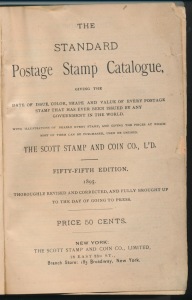The 1895 Scott catalog was a hardbound edition of over 500 pages. The Scott catalog began as J. Walter Scott's price list, and by 1880 had grown into an annual catalog that listed all the stamps of the world that had been issued to that time, whether Scott had them in stock or not. By 1895, the Scott firm was largely out of the business of stamp dealing and had become a publishing company. Their products consisted of an early hardbound version of the Scott International album, which had spaces for all of the stamps listed in the Scott catalog and the Scott catalog itself and by 1895 had grown into a pretty impressive piece of work.
The 1895 catalog listed all of the postage stamps that had been issued by sovereign nations up to that point. The United States section listed all of the special areas that are today reserved for the US specialized catalog including post office provisionals, stationery, locals, and revenues. The biggest difference between the Scott catalog of 1895 and the Scott catalog of today is the fact that Scott used to list the Postal Stationary of worldwide countries until the earliest years of this century. These stamps were not only listed by Scott, but the International album that Scott produced had spaces for the Cut Squares of these Stationary issues as well.
Prices in 1895, as you can imagine, were much lower than they are today. More interesting, the ratio of prices to one another has changed considerably, indicating ascending or declining popularity of certain areas of philately relative to each other. For instance, in 1895 a US #1 cataloged for 75¢, an enormous bargain compared with its current price of $450, but the rate of gain of this stamp over the last 120 years is much smaller than the Penny Black of Great Britain (8¢ (!) then, $300 now). China #3 which now catalogs $900 would have set you back 25¢ then. An additional interesting fact you glean from the catalog is how ratios between mint and used stamp collecting popularity has changed. The clear winner here is mint stamps which have grown in price at nearly twice the rate of used. The same China #3 cataloged 25¢ either mint or used. Today the price of the mint is twice as high ($900 versus $450).
Collectors today are very critical of the price of the Scott catalogs, and the price of the catalog does seem to have gone up quite a bit in real terms. Today, the complete set of catalogs runs to eight huge volumes comprising well over 10,000 pages. The price for a complete set on Amazon is about $680, a considerable sum of money. The value of a US #2 today in Scott is $1,050, so a full set of Scott catalogs is roughly 65% of the current catalog price of a #2. In 1895, a #2 was $3.50. So the 1895 catalog was only 15% of the catalog price of the stamp. Still, today's catalogs are over twenty times larger, fully illustrated, and in color, and because so many collectors specialize, few buy entire sets making the real total cost of Scott catalogs to collectors about the same as it always has been in terms of the cost of collecting.
Those of us who have been around philately most of our lives are forgetful of just what an achievement the major stamp catalogs are and how many thousands of hours went into creating them and making them the centerpieces of our hobby. Our hobby would be impossible without catalogs like Scott, and I doubt that any of the major catalogs could be created today from scratch. Cataloging is about making distinctions— especially which distinctions are worth attending to and which are too trivial for most collectors to bother with. Much of our current agreement about what to collect (what shade and paper varieties are important, for instance) were made for us already by the earlier catalogers. When we enter philately, we enter a world that could have been structured in any number of ways but which has been established in a certain specific manor. Most people either accept the structure of the hobby or find another. The amount of material is too vast and the amount of work too large that, without the structure of earlier catalogs to work with, philately would not be the popular hobby that it is today.
Another great pleasure in looking at the 1895 catalog is how amazingly prices have changed. I can't help thinking that as good an investment as Apple or Google or property or any of these other things have been, a good quantity of money put into Penny Blacks in 1895 would have been a very decent thing for our great grandfathers to have done. $100 in Penny Blacks in 1895 (1,250 Penny Blacks at 8¢ each then) would catalog $375,000 today.

